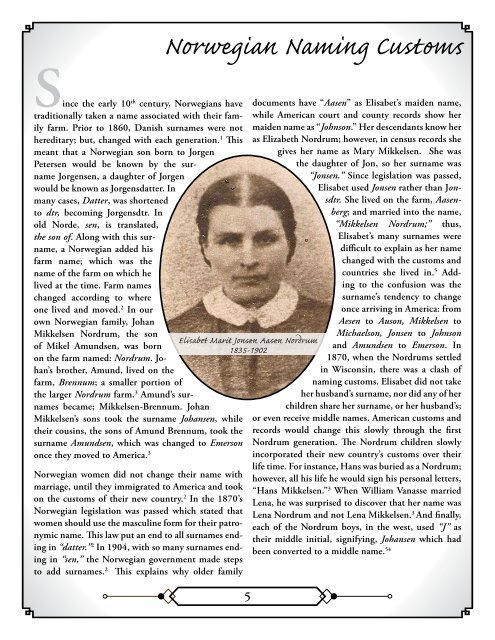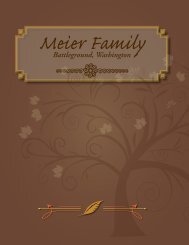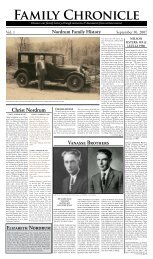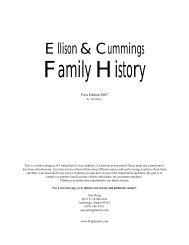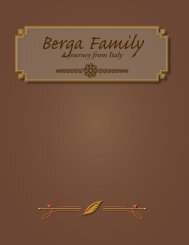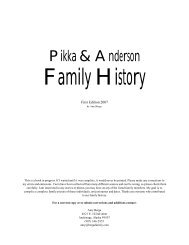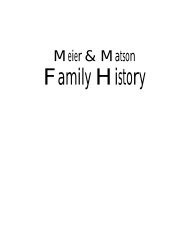Book 2 - Nathan, Amy, Madison and Ethan Berga
Book 2 - Nathan, Amy, Madison and Ethan Berga
Book 2 - Nathan, Amy, Madison and Ethan Berga
Create successful ePaper yourself
Turn your PDF publications into a flip-book with our unique Google optimized e-Paper software.
Norwegian Naming Customs<br />
Since the early 10 th century, Norwegians have<br />
traditionally taken a name associated with their family<br />
farm. Prior to 1860, Danish surnames were not<br />
hereditary; but, changed with each generation. 1 This<br />
meant that a Norwegian son born to Jorgen<br />
Petersen would be known by the surname<br />
Jorgensen, a daughter of Jorgen<br />
would be known as Jorgensdatter. In<br />
many cases, Datter, was shortened<br />
to dtr, becoming Jorgensdtr. In<br />
old Norde, sen, is translated,<br />
the son of. Along with this surname,<br />
a Norwegian added his<br />
farm name; which was the<br />
name of the farm on which he<br />
lived at the time. Farm names<br />
changed according to where<br />
one lived <strong>and</strong> moved. 2 In our<br />
own Norwegian family, Johan<br />
Mikkelsen Nordrum, the son<br />
of Mikel Amundsen, was born<br />
on the farm named: Nordrum. Johan’s<br />
brother, Amund, lived on the<br />
farm, Brennum; a smaller portion of<br />
the larger Nordrum farm. 3 Amund’s surnames<br />
became; Mikkelsen-Brennum. Johan<br />
Mikkelsen’s sons took the surname Johansen, while<br />
their cousins, the sons of Amund Brennum, took the<br />
surname Amundsen, which was changed to Emerson<br />
once they moved to America. 3<br />
Norwegian women did not change their name with<br />
marriage, until they immigrated to America <strong>and</strong> took<br />
on the customs of their new country. 2 In the 1870’s<br />
Norwegian legislation was passed which stated that<br />
women should use the masculine form for their patronymic<br />
name. This law put an end to all surnames ending<br />
in “datter.” 2 In 1904, with so many surnames ending<br />
in “sen,” the Norwegian government made steps<br />
to add surnames. 2 This explains why older family<br />
Elisabet Marit Jonsen Aasen Nordrum<br />
1835-1902<br />
<br />
documents have “Aasen” as Elisabet’s maiden name,<br />
while American court <strong>and</strong> county records show her<br />
maiden name as “Johnson.” Her descendants know her<br />
as Elizabeth Nordrum; however, in census records she<br />
gives her name as Mary Mikkelsen. She was<br />
the daughter of Jon, so her surname was<br />
“Jonsen.” Since legislation was passed,<br />
Elisabet used Jonsen rather than Jonsdtr.<br />
She lived on the farm, Aasenberg;<br />
<strong>and</strong> married into the name,<br />
“Mikkelsen Nordrum;” thus,<br />
Elisabet’s many surnames were<br />
difficult to explain as her name<br />
changed with the customs <strong>and</strong><br />
countries she lived in. 5 Adding<br />
to the confusion was the<br />
surname’s tendency to change<br />
once arriving in America: from<br />
Aesen to Auson, Mikkelsen to<br />
Michaelson, Jonsen to Johnson<br />
<strong>and</strong> Amundsen to Emerson. In<br />
1870, when the Nordrums settled<br />
in Wisconsin, there was a clash of<br />
naming customs. Elisabet did not take<br />
her husb<strong>and</strong>’s surname, nor did any of her<br />
children share her surname, or her husb<strong>and</strong>’s;<br />
or even receive middle names. American customs <strong>and</strong><br />
records would change this slowly through the first<br />
Nordrum generation. The Nordrum children slowly<br />
incorporated their new country’s customs over their<br />
life time. For instance, Hans was buried as a Nordrum;<br />
however, all his life he would sign his personal letters,<br />
“Hans Mikkelsen.” 3 When William Vanasse married<br />
Lena, he was surprised to discover that her name was<br />
Lena Nordrum <strong>and</strong> not Lena Mikkelsen. 3 And finally,<br />
each of the Nordrum boys, in the west, used “J” as<br />
their middle initial, signifying, Johansen which had<br />
been converted to a middle name. 54


